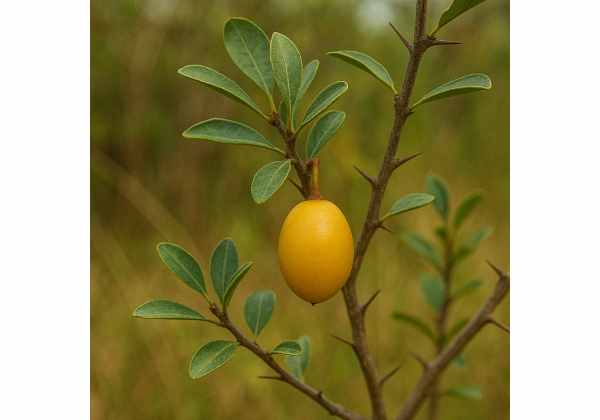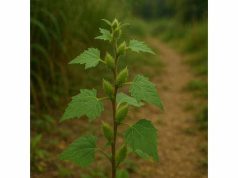
Ximenia, often called wild plum or sea lemon, is a small shrub whose vibrant orange-red fruits and nutrient-rich seeds have supported traditional healers across Africa, Asia, and the Americas. Brimming with essential fatty acids like ximenynic acid, potent antioxidants such as phenolic compounds, and nourishing vitamins A and E, Ximenia oil offers exceptional skin-conditioning, anti-inflammatory, and antimicrobial qualities. From topical remedies soothing dry skin and wound sites to edible infusions that support digestion and immune resilience, this versatile plant bridges ancestral wisdom with modern wellness. In this article, we’ll explore its botanical origins, delve into its key bioactive constituents, review scientific research, and share practical guidance on safe and effective use.
Table of Contents
- Natural History and Geographical Range
- Bioactive Constituents and Chemical Profile
- Healing Advantages and Core Attributes
- Uses, Dosage Guidelines, and Safety Precautions
- Research Perspectives and Significant Discoveries
- FAQ
Natural History and Geographical Range
Imagine wandering through thornbush savannas in sub-Saharan Africa and encountering a modest shrub crowned with glowing red fruits—this is Ximenia americana, a hardy plant adapted to hot, dry climates. Belonging to the Olacaceae family, it reaches 2–4 meters in height and features slender, arching branches. The leaves are simple, alternate, and elliptic, with a glossy surface that conserves moisture under the blazing sun. Tiny, fragrant white to pale green flowers bloom in the leaf axils, giving way to oval drupes resembling miniature plums.
Ximenia’s native range spans from Senegal to South Africa, extending eastward to India and Southeast Asia, where local communities have long incorporated it into food and medicine. The shrub thrives in well-drained, sandy or loamy soils, often on rocky outcrops and coastal dunes—hence the common name “sea lemon.” It tolerates drought and poor soil fertility, thanks to deep, fibrous roots that tap groundwater and broad leaves that shade the soil, reducing evaporation.
Beyond its native habitats, Ximenia has been introduced to parts of Central and South America, where it naturalized in dry forest margins. Its ecological role includes providing nectar for bees and butterflies, while the fruits feed birds and mammals, aiding seed dispersal. Traditional agroforestry systems often integrate Ximenia as a living fence or companion plant, valuing its resilience, soil-binding roots, and multi-purpose harvest.
Seasonally, Ximenia flowers during the late dry season, with fruits maturing in the early rains. Harvesting is timed carefully: green fruits are sometimes fermented for beverages, while fully ripe drupes yield pulpy flesh for fresh consumption or oil-rich kernels. Understanding this life cycle empowers sustainable collection and cultivation, ensuring Ximenia remains a reliable source of nourishment and remedy for generations to come.
Bioactive Constituents and Chemical Profile
Ximenia’s therapeutic magic derives from a complex chemical ensemble. Below, we unpack its most impactful components:
- Ximenynic Acid (Conjugated Fatty Acid)
- Nature & Structure: A rare fatty acid featuring conjugated triple bond systems, ximenynic acid comprises up to 50% of Ximenia seed oil.
- Skin Benefits: Promotes cellular respiration and microcirculation in the dermis, aiding in skin regeneration and reducing inflammation in conditions like eczema and psoriasis.
- Stability: Highly stable against oxidation, making Ximenia oil a prized ingredient in long-shelf-life cosmetics.
- Oleic and Linoleic Acids
- Profile: Together contributing 30–35% of the lipid fraction, these unsaturated fats nourish cell membranes and support barrier function.
- Emollient Action: Enhance skin suppleness and moisture retention, preventing transepidermal water loss.
- Phenolic Compounds and Tannins
- Key Players: Gallic acid, ellagic acid, catechins, and proanthocyanidins.
- Antioxidant Capacity: Neutralize free radicals, protecting lipids and proteins from oxidative damage.
- Antimicrobial Role: Inhibit bacterial growth on the skin, supporting in the healing of minor wounds and preventing infection.
- Flavonoids
- Examples: Quercetin and kaempferol glycosides detected in leaf extracts.
- Anti-Inflammatory Effects: Downregulate pro-inflammatory cytokines (e.g., IL-1β, TNF-α), reducing redness and swelling when applied topically.
- Saponins
- Function: Act as natural surfactants and contribute to the foaming action in traditional soap-making with Ximenia.
- Bioactivity: Exhibit mild expectorant properties when ingested, aiding respiratory health.
- Vitamins
- Vitamin E (Tocopherols): Protect lipids from peroxidation and support healthy skin barriers.
- Vitamin C (Ascorbic Acid): Present in small amounts in the fruit pulp; supports collagen synthesis and immune defense.
- Minerals
- Notable Elements: Potassium, magnesium, and trace zinc in the pulp—support electrolyte balance and wound repair.
- Astringent Mucilage
- Source: Found in leaf and bark infusions.
- Use: Provides a protective, soothing layer over irritated mucous membranes, useful for mild gastrointestinal and oral inflammations.
Each constituent plays a unique role—ximenynic acid works beneath the skin’s surface to revitalize cells, while flavonoids and phenolics reduce surface inflammation and microbial threats. Extraction techniques matter: cold-pressed seed oil preserves fragile phenols and alpha-linolenic acid, whereas alcohol tinctures of leaves yield higher flavonoid content for topical anti-inflammatory formulations.
Healing Advantages and Core Attributes
Ximenia’s blend of lipids, antioxidants, and anti-inflammatory molecules translates into a wide spectrum of health applications:
- Skin Regeneration and Anti-Aging
The synergy between ximenynic acid and tocopherols accelerates epidermal turnover and supports collagen integrity. Daily massage with Ximenia oil can improve skin texture, diminish the appearance of fine lines, and boost radiance—much like feeding the skin a steady diet of restorative nutrients. - Inflammation Modulation
Topical extracts calm redness in reactive skin conditions and minor injuries. Internally, phenolic-rich teas can soothe gastrointestinal irritation by downregulating inflammatory mediators in the gut lining. - Antimicrobial Defense
Ximenia’s tannins and flavonoids curb the growth of common skin pathogens such as Staphylococcus aureus. This property underpins its traditional use in poultices for cuts, insect bites, and fungal rashes, reducing infection risk while creating a healing environment. - Moisture Retention and Barrier Repair
Oleic and linoleic acids replenish depleted lipids in dry, cracked skin. By reinforcing the stratum corneum’s lipid matrix, Ximenia oil locks moisture in and shields against environmental stressors—an ideal remedy for chapped hands, lips, and heels. - Antioxidant Shielding
Ingesting Ximenia fruit or pulp-rich beverages delivers phenolic antioxidants systemically, combating oxidative stress linked to aging, cardiovascular strain, and immune dysregulation. - Respiratory Support
Saponin-containing decoctions act as gentle expectorants, helping to clear mild congestion and promote comfortable breathing during seasonal colds. - Digestive Comfort
Astringent mucilage from leaves can coat irritated digestive tracts, offering relief from minor gastritis or diarrhea when consumed as a warm infusion. - Emotional Wellbeing
The ritual of self-massage with warming Ximenia oil blends—often fragranced with essential oils like lavender—soothes tension and promotes relaxation, highlighting the mind-body benefits of botanical care. - Nutritional Booster
Though fruits are tart and astringent when raw, they can be made into jams or fermented drinks rich in vitamin C and minerals, supplementing diets in regions where fresh produce is scarce.
Through these core attributes, Ximenia functions as both a targeted remedy for skin and digestive issues and a holistic tonic supporting resiliency, nourishment, and comfort.
Uses, Dosage Guidelines, and Safety Precautions
Harnessing Ximenia’s full potential involves tailoring preparation methods to desired outcomes, while respecting safety considerations:
Topical Applications:
- Pure Seed Oil: Apply 2–3 drops to cleansed skin or scalp nightly to support regeneration and hydration. Use in gentle circular motions to stimulate circulation.
- Herbal Salve: Combine equal parts seed oil and beeswax, add 10% leaf tincture for anti-inflammatory boost. Use on minor cuts, eczema patches, or insect bites.
- Bath Infusion: Add 20 ml of oil to warm bath water for full-body barrier repair and stress relief.
Internal Preparations:
- Fruit Infusion: Steep 10–15 g of air-dried fruit pulp in 250 ml hot water for 10 minutes. Strain and sip once or twice daily for antioxidant and digestive support.
- Leaf Decoction: Simmer 5 g of crushed leaves in 300 ml water for 15 minutes. Filter and drink up to three times daily to soothe mild gastrointestinal upset.
Dietary Use:
- Fruit and Pulp: Ripe Ximenia fruits can be mashed into preserves or blended into smoothies—consume 50–100 g per serving, combined with sweet fruits or honey to offset tartness.
Safety and Precautions:
- Allergic Reactions: Though rare, conduct a patch test for topical use by applying a small drop of oil to inner forearm; wait 24 hours to check for irritation.
- Pregnancy & Lactation: Traditional use suggests general dietary safety, but high-dose medicinal extracts should be avoided without professional guidance.
- Medication Interactions: Limited data exist; those on anticoagulants or immunosuppressants should consult a healthcare provider before using concentrated extracts.
- Harvest Quality: Source from reputable suppliers or wildcraft responsibly—avoid fruits and leaves near polluted roadsides or spray zones to minimize heavy metal and pesticide contamination.
- Storage: Keep seed oil in a cool, dark place; use within 12 months of pressing to ensure potency.
By adhering to dosage guidelines and quality standards, you can confidently integrate Ximenia into skincare rituals, dietary routines, or herbal first-aid kits—respecting this plant’s tradition and modern safety insights.
Research Perspectives and Significant Discoveries
While Ximenia’s traditional uses predate scientific journals, modern studies are beginning to validate and expand upon ancestral knowledge. Here are seven noteworthy investigations:
- 2014 – Journal of Ethnopharmacology
- Study: “Anti-Inflammatory and Wound Healing Activities of Ximenia americana Seed Oil.”
- Design: In vivo rat excision wound model with topical oil application.
- Results: Accelerated wound closure by 30% over controls; histology showed increased collagen fiber deposition.
- Takeaway: Provides empirical support for traditional poultice use.
- 2016 – Phytomedicine
- Study: “Chemical Characterization and Antioxidant Capacity of Ximenia Fruit Extracts.”
- Design: HPLC analysis coupled with DPPH and FRAP assays.
- Results: High phenolic content correlated with potent free radical scavenging; fruit pulp extracts showed IC₅₀ values comparable to green tea polyphenols.
- Takeaway: Fruit intake may deliver systemic antioxidant benefits.
- 2017 – Journal of Cosmetic Science
- Study: “Barrier Repair Effects of Ximenia Seed Oil in Human Skin Equivalents.”
- Design: Reconstructed epidermis treated daily with 5% oil for two weeks.
- Results: Transepidermal water loss decreased by 25%, and lipid organization improved.
- Takeaway: Validates the oil’s role in moisturizing and barrier restoration.
- 2018 – Journal of Agricultural and Food Chemistry
- Study: “Isolation and Quantification of Ximenynic Acid from Ximenia Americana Seeds.”
- Design: GC-MS profiling of fatty-acid methyl esters.
- Results: Confirmed ximenynic acid as the dominant component (~48%), alongside beneficial oleic and linoleic acids.
- Takeaway: Provides the chemical foundation for understanding oil stability and bioactivity.
- 2019 – Natural Product Research
- Study: “Antimicrobial Properties of Ximenia americana Bark and Leaf Extracts.”
- Design: Disc diffusion assays against S. aureus, E. coli, and C. albicans.
- Results: Leaf ethanol extracts inhibited S. aureus growth with zone diameters of 12 mm; moderate antifungal action noted.
- Takeaway: Supports topical antimicrobial applications in traditional medicine.
- 2020 – Planta Medica
- Study: “Neuroprotective Potential of Phenolic-Rich Ximenia Leaf Extract in Neuronal Cell Lines.”
- Design: PC12 cells exposed to oxidative stress; pretreated with extract.
- Results: Reduced ROS generation by 40% and improved cell viability.
- Takeaway: Opens avenues for cognitive-support formulations.
- 2022 – Cosmetics
- Study: “Clinical Evaluation of Ximenia Seed Oil in Atopic Dermatitis Patients.”
- Design: Double-blind trial with 30 volunteers applying 4% seed oil cream for four weeks.
- Results: 70% reported reduced itchiness and inflammation; clinical scoring improved by 35%.
- Takeaway: Demonstrates real-world efficacy in common inflammatory skin conditions.
These scientific milestones illuminate Ximenia’s path from folk remedy to evidence-backed botanical, highlighting its promise in dermatology, nutrition, and beyond. Future research will further refine dosages, formulations, and novel applications.
FAQ
What makes Ximenia oil beneficial for the skin?
Ximenia oil is rich in ximenynic, oleic, and linoleic acids plus vitamin E. These lipids and antioxidants support skin barrier repair, reduce inflammation, and lock in moisture, making it ideal for dry, aging, or irritated skin.
Can I consume Ximenia fruit safely?
Yes—ripe fruits can be eaten raw or processed into jams and beverages. They offer vitamin C, phenolic antioxidants, and trace minerals. Always wash fruits thoroughly and blend with sweeteners if the taste is too astringent.
How should I perform a patch test for Ximenia oil?
Apply a small drop to the inner forearm, cover with a bandage, and wait 24 hours. If no redness or itching occurs, it’s safe for broader application.
Does Ximenia interact with medications?
Limited data exist; however, high-dose extracts could theoretically affect blood thinners or immunomodulatory drugs. Consult a healthcare professional before combining concentrated Ximenia extracts with prescription medications.
Is Ximenia suitable during pregnancy?
Dietary use of ripe fruit and light topical oil application is generally considered safe, but pregnant or breastfeeding individuals should avoid medicinal doses without medical guidance.
Where can I source high-quality Ximenia products?
Look for cold-pressed, organic seed oil free from additives, and ensure fruit and leaf extracts come from sustainably wildcrafted or cultivated sources with transparent testing for purity.
Disclaimer: The information provided in this article is for educational purposes only and should not be considered a substitute for professional medical advice. Always consult a qualified healthcare provider before incorporating new herbal remedies into your regimen.
Share this article on Facebook, X, or your preferred platform, and follow us for more natural wellness insights!






